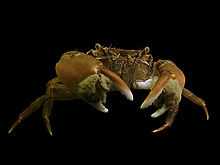Hemigrapsus takanoi
| Hemigrapsus takanoi | |
|---|---|
 | |
| Frontal view of male, showing the large patches of setae on the claws | |
| Scientific classification | |
| Kingdom: | Animalia |
| Phylum: | Arthropoda |
| Subphylum: | Crustacea |
| Class: | Malacostraca |
| Order: | Decapoda |
| Infraorder: | Brachyura |
| Family: | Varunidae |
| Genus: | Hemigrapsus |
| Species: | H. takanoi |
| Binomial name | |
| Hemigrapsus takanoi Asakura & Watanabe, 2005[1] | |
Hemigrapsus takanoi, the brush-clawed shore crab or Asian shore crab, is a small crab of the family Varunidae (formerly classified as Grapsidae) that lives on rocky shores surrounding the Pacific Ocean. This crab is omnivorous and eats small fish, invertebrates and algae.
Description
Prior to 2005, the name Hemigrapsus penicillatus was used to cover animals that are now known to represent two distinct species. Hemigrapsus penicillatus (sensu stricto) has smaller patches of setae (bristles) on the chelae (claws) in males; Hemigrapsus takanoi has larger setal patches and larger coloured spots on the exoskeleton.[2] It can be a variety of colors, including orange-brown, maroon, or green, with striped legs and spotted claws. Male brush-clawed shore crabs have a patch of light brown or yellow bristles (known as setae) on their chelae (pincers). Their carapace width typically reaches about 2.5 centimetres (1.0 in), and has three spines. Before developing into juvenile crabs, larval brush-clawed crabs spend almost one month floating in the ocean. This allows them to find food and new habitats.[3]
Distribution
Hemigrapsus takanoi is native to Japan and China, although the limits of its distribution are still unclear.[2] H. takanoi has also been introduced to the coasts of Europe by human agency, and has become an invasive species there. Although originally reported as Hemigrapsus penicillatus, that species has since been divided into two species, and it is H. takanoi, not H. penicillatus which occurs on the coasts of Europe.[2] It is thought to have arrived in 1993, having been discovered in La Rochelle, France, in 1994. A study of hull fouling animals on ships in Hamburg Dockyard and Bremerhaven at the time found six specimens of H. takanoi on the car-carrying ship SPICA, which travelled between the Asian ports of Tokyo, Osaka, Kobe and Pusan, and Europe. The ship was known to have passed the French coast in 1993, and it is thought that the introduction is likely to have occurred when crabs fell from the hull of the SPICA at that time.[4]
By 1997, its range in Europe extended from Fromentine in France (adjacent to the Île de Noirmoutier) to Laredo, Spain, covering a coastline of 700 kilometres (430 mi) around the Bay of Biscay.[5] By 1999, it had reached Le Havre on the English Channel, and by 2005, it had reached the French Opal Coast at the entrance to the North Sea.[6] Predictions based on its native climate suggest that H. takanoi will spread across much of the North Sea and western parts of the Baltic Sea.[4]
References
- ↑ Akira Asakura & Seiichi Watanabe (2005). "Hemigrapsus takanoi, new species, a sibling species of the common Japanese intertidal crab H. penicillatus (Decapoda: Brachyura: Grapsoidea)". Journal of Crustacean Biology 25 (2): 279–292. doi:10.1651/C-2514.
- ↑ 2.0 2.1 2.2 Akira Asakura & Seiichi Watanabe (2005). "Hemigrapsus takanoi, new species, a sibling species of the common Japanese intertidal crab H. penicillatus (Decapoda: Brachyura: Grapsoidea)" (PDF). Journal of Crustacean Biology 25 (2): 279–292. doi:10.1651/C-2514.
- ↑ Salem Sound Coastwatch. "Hemigrapsus takanoi, brush-clawed shore crab" (PDF). Guide to Marine Invaders in the Gulf of Maine. Government of Massachusetts. Retrieved November 24, 2011.
- ↑ 4.0 4.1 S. Gollasch (1999). "The Asian decapod Hemigrapsus penicillatus (de Haan, 1835) (Grapsidae, Decapoda) introduced in European waters: status quo and future perspective" (PDF). Helgoländer Meeresuntersuchungen 52: 359–366.
- ↑ Pierre Y. Noël, Emmanuel Tardy & Cédric d'Udeken d'Acoz (1997). "Will the crab Hemigrapsus penicillatus invade the coasts of Europe?" [Le crabe Hemigrapsus penicillatus envahira-t-il les côtes européennes ?] (PDF). Comptes rendus de l'Académie des sciences. III: sciences de la vie 320: 741–745. doi:10.1016/S0764-4469(97)84823-8.
- ↑ Jean-Claude Dauvin, Armonie Tous Rius & Thierry Ruellet (2009). "Recent expansion of two invasive crabs species Hemigrapsus sanguineus (de Haan, 1835) and H. takanoi Asakura and Watanabe 2005 along the Opal Coast, France". Aquatic Invasions 4 (3): 451–465. doi:10.3391/ai.2009.4.3.3.
External links
 Media related to Hemigrapsus takanoi at Wikimedia Commons
Media related to Hemigrapsus takanoi at Wikimedia Commons